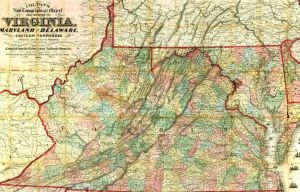 With cold weather retreating, soldiers in the North Carolina 1st Infantry Regiment are gearing up for the spring campaign after wintering near the Rapidan and doing picket duty along the river at Mitchell’s Ford during the late fall and winter of 1863-64.
With cold weather retreating, soldiers in the North Carolina 1st Infantry Regiment are gearing up for the spring campaign after wintering near the Rapidan and doing picket duty along the river at Mitchell’s Ford during the late fall and winter of 1863-64.
Amongst them is Baptist William Robert Gwaltney, 27, a native of Alexander, North Carolina, who, along with others, would surely miss the relative safety and calm of now familiar quarters. During their stay there he had been a source of solace and encouragement to his fellow soldiers.
“Rev. W. R. Gwaltney, chaplain of the regiment, wrought a good work here,” wrote one who knew. “A large chapel was constructed, in which regular services were held for the soldiers. He also established a school for them, which did much to improve their condition in every way.”
The young man with big blue eyes had also been known to console the injured in medical wards. While in Richmond’s General Hospital #9, Gwaltney wrote of the spiritual experiences in this “receiving” hospital near the Virginia Central Railroad depot. He called it by its name from pre-war days when the building was a city-owned public warehouse established initially by John Seabook. The hospital was designed to hold 900 patients and employed about 150. Medical and religious personages met soldiers arriving mangled and fresh from battle.
“The Lord is with us at Seabrooks’ hospital,” wrote Gwaltney, probably that summer as North Carolina’s finest checked in and out. “We have a great revival of religion here. A greater one I scarcely ever witnessed. Rarely a day passes but I find one or more new converts. The number in our hospital is being rapidly reduced, many being transferred to other places, and many having died; but the religious element in our midst is by no means dying out. A large number are yet enquiring, ‘What must we do to be saved?’ Those who have professed a hope in Christ seem to be in the full enjoyment of faith.” Seabrook’s took in and transferred out thousands of wounded and sick patients. Some died, some were furloughed, some were treated and sent back to fight again. Soldiers were treated by physicians, nurses, community volunteers, and chaplains.
Born to Howell L. and Alcy Elsie Hendren Gwaltney on 10 September 1835, William had become a young man of intelligence and ability. He entered Wake Forest College in 1860, left when the war took its toll on the educational facility, enlisted with the 1st North Carolina in December 1862, and was then ordained in 1863. Following the war, William returns to Wake Forest and finishes his degree in 1867. He marries during that time and after graduation takes his first pastorate at Hillsboro, North Carolina.
At his death in December 1907, great lamentation arose, mingled with praise for his worthy life. “Dr. Gwaltney was known as the ‘great church builder of the State,’ among the brethren of his day,” read a Biblical Recorder death notice. “His venerable appearance, approaching our conception of that of the patriarch, will ever be fresh in our memory and we shall miss him in the service of his Master, but we shall be cheered for generations yet to come by the fruit of his labors.” Gwaltney was a dependable trustee of his alma mater and promoter and trustee of Thomasville Orphanage.
But 150 years ago today all that is another generation down the road. On this day, Gwaltney gathers his belongings to step out towards an enemy he and the others will meet on the first day of the Battle of the Wilderness. On this day William R. Gwaltney has much before him.
Contributed by Arlette Camp Copeland, Mercer University Tarver Library Special Collections, Macon, GA.
Sources: “A Prince In Israel Has Fallen,” Biblical Recorder, 18 December 1907, 1; William W. Bennett, A Narrative of The Great Revival Which Prevailed in the Southern Armies, 1876, page 178; Histories of the several regiments and battalions from North Carolina, in the great war 1861-’65, page 150; William Robert Gwaltney biographical folder, Mercer University Tarver Library Special Collections; Ancestry.com; “General Hospital #9,” Civil War Richmond (link)


